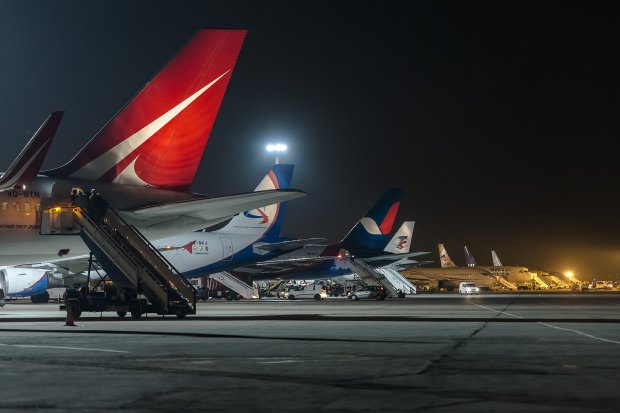Varna and Burgas Welcomed More Passengers and Flights in 2017

Wizz Air and Ryanair announced new bases on the Black Sea coast
Bulgaria’s Black Sea airports welcomed a record number of passengers last year – a total of 4,953,039. The registered passenger growth is 8.42 percent, and given that 2016 had an enormous growth of 22 percent, this is a major success, explained Ulrich Heppe, CEO of Fraport Twin Star Airport Management AD.
Although in 2017 one of the major markets – the Russian – fell 11 percent, Fraport Twin Star has no reason to worry about the overall performance of its airports. Other markets compensated for the decline of Russian tourists – there was an increase in passengers from the United Kingdom, Germany, Israel, Norway, Poland and the Czech Republic.
"As an operator active at 30 airports, Fraport sees world tourist trends, and we notice that the Russians are returning to Turkey and Egypt," Heppe said. "After the relations between Russia and Turkey improved, the Russian tour operators decided to go back to Turkey, which led to a reduced number of Russian tourists in Varna and Burgas. Nevertheless, in 2017, Russia remained a key foreign market for our Bulgarian airports, along with the UK and Germany."
In the last year, Fraport achieved a 4.83-percent increase in flights, with a total of 37,416 take-offs and landings. A record number of flights were welcomed on July 14 in Burgas - 262 aircrafts for 24 hours, and on July 18 in Varna - 130 aircrafts. Additionally, the Black Sea airports continued to provide air freight to all parts of the world. Last year, Varna transported 229 tons of cargo and Burgas 14,300 tons.
The year ended with excellent news for the two airports – Varna and Burgas became the first airports in Bulgaria to receive the European EASA Airport certification. On December 29th, the two airports received their aerodrome licenses from the European Aviation Safety Agency, whose standardization activities are focused on safety performance and on the efficient use of resources. “We are proud that our airports fulfil the highest European safety standards,” Heppe said.
He also explained that seasonality continues to be the airports’ biggest challenge. "One of our main goals is to increase traffic in the spring, autumn and winter and we are working in this direction. In 2017, for example, Varna had an absolute record – in October, Varna Airport had +48 percent passengers, in November +91 percent passengers, and in December +88 percent passengers, thanks to the newly opened year-round destinations by low-cost carriers.”
Varna Airport
In 2017, Varna Airport had flights to 116 destinations in 40 countries. The airport served 1,970,700 passengers, which marks an increase of 16.64 percent. Most passengers arrived from Germany – 510 740, followed by Bulgaria (250 700), Russia (213 936), Poland (159 280) and the United Kingdom (136 038). The largest increase is seen among travelers from Bulgaria (82%) and the Czech Republic (71%). For those departing from Varna, the most preferred destinations were Sofia, Moscow, London, Tel Aviv and Düsseldorf.
In June 2017, the British low-cost carrier easyJet launched two new lines – London Gatwick and Berlin Schönefeld, and, in July, Wizz Air Base 28 opened in Varna. This made Varna Airport the second operational base for Wizz Air in Bulgaria. The Hungarian carrier increased the number of destinations served by Varna to eight: Dortmund, Munich Memmingen, Eindhoven, Larnaca, Milano Bergamo, Tel Aviv, London Luton and Sofia.
On October 29th, Ryanair also established presence at Varna Airport, starting a new route from Varna to Brussels Charleroi. In total, 11 new airlines flew to and from Varna in 2017, and last summer Varna Airport had 13 new destinations to Germany, Lithuania, Finland, the Czech Republic, Italy, Greece, Belgium, Spain, Cyprus, the Netherlands and Croatia.
The last year also saw some additional investments from Fraport. At Varna Airport, the system for management and control of the lighting equipment was replaced. Estimated at 2.92 million BGN, this project involved the installation of new voltage regulators, new approach lights and new power-supply routes. At the moment, Fraport is conducting two other major projects in Varna – the reconstruction of the hangar, where aircraft get repaired, and the reconstruction of taxiway Alpha, the longest and most used taxiway at the airport.
Burgas Airport
In 2017, Burgas Airport had flights to 153 destinations in 43 countries. The number of registered passengers was 2,982,339, which is an increase of 3.59 percent. Most passengers arrived from Russia – 660,284, followed by the United Kingdom (448,692), Germany (398,620), Poland (319,023) and the Czech Republic (262,839). The highest passenger growth came from the Czech Republic (20%) and Denmark (18%). For those departing from Burgas, the most preferred destinations were Moscow, Prague, London, Tel Aviv and Katowice.
The year ended with good news for Burgas: Ryanair announced that it will open a new base at the airport in late March 2018. Base №87 brings an investment of 100 million USD and 11 new routes: Bratislava, Düsseldorf Weeze, Frankfurt-Hahn, Krakow, Munich Memmingen, Milan Bergamo, Riga, Rzeszow, Tel Aviv, Warsaw Modlin and Kaunas.
This year, nine new airlines flew from and to Burgas, and the summer season included 10 new destinations in Germany, Sweden, Ukraine, Finland, France, Greece, Lithuania and Iceland.
Fraport's investments continued in Burgas, too, where the rehabilitation projects for taxiway Alpha and the new lighting system were completed. Next, the airport will enlarge and redesign its apron area to optimize its aircraft stands to increase airside capacity.
For its investments and contribution to the regional economy, in December 2017, Fraport was recognized by the Burgas Chamber of Commerce with an award in the category Big Enterprises. So far, for the first 10 years of its concession, the operator of the Black sea airports has invested 350 million BGN in Varna and Burgas. It is expected to invest another 256 million BGN by 2027.


